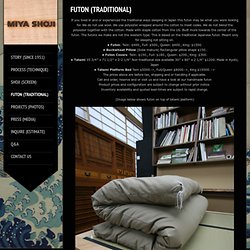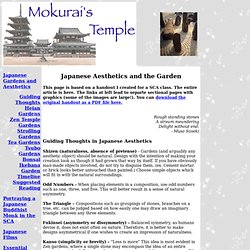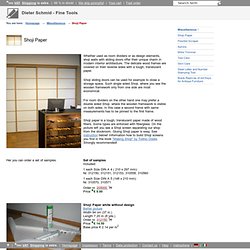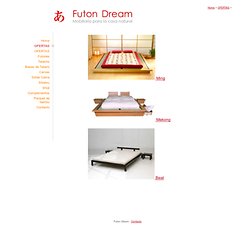

Yuugou by Greensabbath. Foreword by Brett Thomas It's always fun to see a great mod take shape, but it's even better when it's a great mod that comes off as polished as some of the work that Nick Falzone does.

Those of you who are familiar with our forums will recognise him as Greensabbath, and this isn't the first time he's graced these front pages. Nick's first mod, Sangaku was an incredibly detailed testamant to his woodworking and acrylic skills. But how do you follow up a piece of work like that? Well, back to the woodshop and many months of hard work later, Nick has brought us a worthy successor. Introduction After finishing my first case mod, Sangaku, I thought to myself “That was fun, but I think I’ve had enough.”
From left to right: Ise Shrine; Greene & Greene's Gamble House; Japanese Lamp by Nick Falzone. Shoji : Hinged Doors. Zen Home Decor & Japanese Inspired Living; Furniture, Meditation, Kimonos, Gifts, Shoji Screens, more. FUTON (TRADITIONAL) « MIYA SHOJI – Japanese shoji screen partition dividers sliding and freestanding. If you lived in and or experienced the traditional ways sleeping in Japan this futon may be what you were looking for.

We do not use wool. We use polyester wrapped around the cotton to meet codes. We do not blend the polyester together with the cotton. Made with staple cotton from the US. Built more towards the center of the futon. . • Futon: Twin: $400., Full: $500., Queen: $600., King: $1500. Japanese Aesthetics and Garden Design. Guiding Thoughts in Japanese Aesthetics Shizen (naturalness, absence of pretense) - Gardens (and arguably any aesthetic object) should be natural.

Design with the intention of making your creation look as though it had grown that way by itself. Untitled. Wabi-sabi for artists, designers, poets & philosophers - Leonard Koren. This is an updated version of the enduring classic that first introduced the concept of “imperfect beauty” to the West.

Text, images, and book design seamlessly meld into a wabi-sabi-like experience. Wabi-sabi is a beauty of things imperfect, impermanent, and incomplete . . . . . . wabi-sabi could even be called the “Zen of things,” as it exemplifies many of Zen’s core spiritual-philosophical tenets . . . Wabi-sabi is the most conspicuous and characteristic feature of what we think of as traditional Japanese beauty.
It occupies roughly the same position in the Japanese pantheon of aesthetic values as do the Greek ideals of beauty and perfection in the West . . . Five Steps to Selecting and Ordering Your Stock Shoji Screens finely crafted of USA hardwoods & durable papers by Cherry Tree Design. Zen Home Decor & Japanese Inspired Living; Furniture, Meditation, Kimonos, Gifts, Shoji Screens, more.
Shoji Screens for Sliding Doors and Dividers. Cherry Tree Design has enhanced the charm of the original shoji designs with the utilization of solid American hardwoods and durable, washable facings.

Traditionally, Shoji contain grid work on one side with a thin paper glued to the back of the screens, which was replaced every Japanese New Year. Our In-Stock and Custom Shoji feature double sided grid, which may be removed for cleaning or to change the facing. When a single-sided solution will do, consider our new Quick Fit Shoji products, which can be built to your exact dimensions and feature an innovative wedge system to secure the facing to the backside without the need for messy gluing. MIYA SHOJI – Japanese shoji screen partition dividers sliding and freestanding. KODAMA. Standard Shoji Screens/Doors Informational Guide. MAKE SHOJI. Shoji: How to Design, Build, and Install Japanese Screens.
Shoji Products in Queensland. We're Sorry. 404 page not found… The item you have requested no longer exists, so you've got this friendly 404 error page instead.Either you've mistyped, followed an outdated link or we've renamed or removed the page.Please choose something from the navigation menu above, or try…Our home pageOur comprehensive sitemapContacting DesThanks for visiting our website.

[Sleeker_special_clear] Shoji and Kumiko Design. Mend a Paper or Shoji... The paper on shoji windows or screens is customarily changed on the last day of lunar calender year, signifying a fresh new start.

How to make Traditional Rice Paste Both the Chinese and Japanese use rice paste for their paper. The homemade paste dries transparent and its consistency and drying time eases application. Dont use PV or Acrylic Glue as this will take stain from the wood 1. Wash ordinary rice with cold water, until the water is clear. 2. Drain the rice for about 12 hours and cover it with a damp cloth to prevent drying up. 3. Shoji: How to Design, Build, and Install Japanese Screens - Jay van Arsdale. Shoji books.
How to Build a Shoji Screen. The making of a Japanese-style shoji door. MAKE SHOJI. JustThis: Traditional Shoji Screens. Grace Riggan (info@homeplace.biz) Grace Riggan, who has shared with us her thoughts on building, is a member of the Austin Zen Center.

She and Joshua Bowles design and craft homes and spaces through HomePlace Architecture + Carpentry. Shoji Paper. Whether used as room dividers or as design elements, shoji walls with sliding doors offer their unique charm in modern interior architecture.

The delicate wood frames are covered on their reverse sides with a tough, translucent paper. Shoji sliding doors can be used for example to close a storage space. Such single sided Shoji, where you see the wooden framework only from one side are most economical. For room dividers on the other hand one may prefer a double sided Shoji, where the wooden framework is visible on both sides. In this case a second frame with same measurements has to be pinned to the first frame. Shoji- How to Design, Build, and Install Japanese Screens. Cómo cortar listones de madera. Wabi-sabi for artists, designers, poets & philosophers - Leonard Koren. This is an updated version of the enduring classic that first introduced the concept of “imperfect beauty” to the West. Text, images, and book design seamlessly meld into a wabi-sabi-like experience. Wabi-sabi is a beauty of things imperfect, impermanent, and incomplete . . . . . . wabi-sabi could even be called the “Zen of things,” as it exemplifies many of Zen’s core spiritual-philosophical tenets . . .
Wabi-sabi is the most conspicuous and characteristic feature of what we think of as traditional Japanese beauty. It occupies roughly the same position in the Japanese pantheon of aesthetic values as do the Greek ideals of beauty and perfection in the West . . . OFERTAS. Ming.

Puertas japonesas deslizantes. La cultura japonesa nunca ha dejado de impresionar a todos los demás en este planeta. Desde dispositivos de alta tecnología hasta diseños arquitectónicos de vanguardia, más y más personas están interesadas en productos hechos en esta parte del mundo y cuando se trata de diseño de interiores, las puertas japonesas deslizantes son una de las cosas que más llaman la atención.
También se les llama “fusuma” o “shoji” en japonés y cada vez son más populares en muchas casas porque son excelentes para ahorrar espacio. Se usan para separar habitaciones individuales de pasillos u otros cuartos en las casas japonesas tradicionales y que ahora se usan cuando se decora un hogar al estilo moderno. SHOJI JAPANESE PAPER <<Tissue, Japanese And Natural Paper <<Paper, Cardboard, Paperboard. Search Results for:shoji.
Amazon. Welcome To. Panel Japones - Cortinas y Persianas en Decoración. Curso. Papel shoji. 彦根仏壇を作っています・・・障子の金具打ち. Manufacturer supplier from Taiwan wholesaler distributor-Ming-Muh Art Enterprise Co., Ltd. Washitsu. Muromachi period. The Muromachi period (室町時代, Muromachi jidai? , also known as the Muromachi era, the Ashikaga era, or the Ashikaga period) is a division of Japanese history running from approximately 1337 to 1573. The period marks the governance of the Muromachi or Ashikaga shogunate (Muromachi bakufu or Ashikaga bakufu), which was officially established in 1338 by the first Muromachi shogun, Ashikaga Takauji, two years after the brief Kemmu restoration (1333–1336) of imperial rule was brought to a close. The period ended in 1573 when the 15th and last shogun of this line, Ashikaga Yoshiaki, was driven out of the capital in Kyoto by Oda Nobunaga.
From a cultural perspective, the period can be divided into the Kitayama and Higashiyama periods (later 15th - early 16th). The early years from 1336 to 1392 of the Muromachi period are known as the Nanboku-chō or Northern and Southern Court period. Ashikaga bakufu[edit] Japanese rock garden. Ryōan-ji (late 15th century) in Kyoto, Japan, a famous example of a zen garden A mountain, waterfall, and gravel "river" at Daisen-in (1509–1513) History[edit] Early Japanese rock gardens[edit] Rock gardens existed in Japan at least since the Heian Period (784-1185). Shoji Paper. Custom Shoji Screens by Bush Woodcraft. Shoji Screens During the Heian period (800 A.D.) to the early Edo period (1876 A.D.).
Samurai practiced woodworking in their spare time. Bush Art Craft, the Americanized version of the name "Bushi Kogi" (lit. KODAMA. Shoji Screen And Door Close Up Photo. Amazon. Handcrafted Shoji Screens and Doors, Room Dividers, Platform Beds, Tatami Mats. Kona Shoji Design. Joinery Notebook. eBay 【セカイモン】- スクリーン、間仕切り < 家具 < 日用品・ガーデニング: 海外オークション. FUSUMA. File:Tenryuji Kyoto29s5s4200.jpg. Tokonoma. Tokonoma (床の間, toko-no-ma[1]?) , also referred to simply as toko,[citation needed] is a Japanese term generally referring to a built-in recessed space in a Japanese style reception room, in which items for artistic appreciation are displayed. In English, tokonoma is usually called alcove. The items usually displayed in a tokonoma are calligraphic or pictorial scrolls and an arrangement of flowers.
Bonsai and okimono are also sometimes displayed there, although traditionally, bonsai were considered to be too dirty for such a highly respected place. The tokonoma and its contents are essential elements of traditional Japanese interior decoration. When seating guests in a Japanese-style room, the correct etiquette is to seat the most important guest with his or her back facing the tokonoma. Stepping within it is strictly forbidden, except to change the display when a strict etiquette must be followed. Tokonoma. Fusuma - 3D Warehouse Search. Shoji - 3D Warehouse Search. Shoji – Flickr : Rechercher. Shoji. JAANUS / takeshouji 竹障子. Fusuma. How to Build Japanese Shoji Screens. How To Make Shoji Screens. Many people want to learn how to build a shoji screen to add to their sleek and modern décor. Traditional shoji screens are made from rice paper and bamboo, but when you build your own you can implement your own ideas and materials. To build a shoji screen, you will need: Wood Paint or stain Paintbrush Nails Screws Hammer Drill Glue Hinges Wood chisel Jig saw Construct your frame.
Using one by two lumber cut twelve pieces that are seven feet long. Shoji Screens (full text) Shoji. Shoji: How to Design, Build, and Install Japanese Screens - Jay van Arsdale.